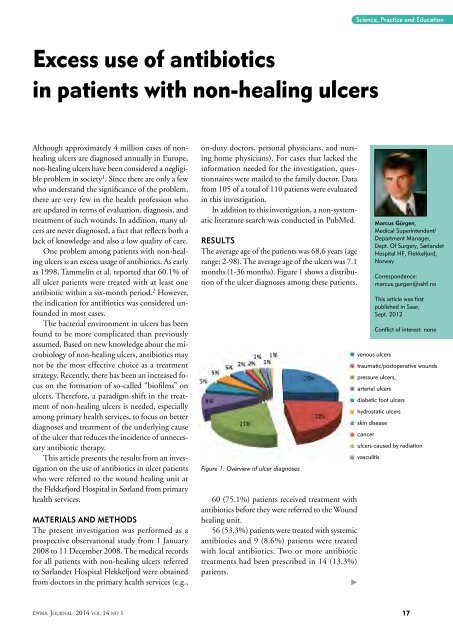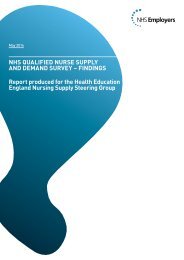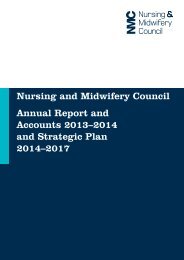Journal_1_2014_final_WEB
Journal_1_2014_final_WEB
Journal_1_2014_final_WEB
Create successful ePaper yourself
Turn your PDF publications into a flip-book with our unique Google optimized e-Paper software.
Science, Practice and Education<br />
Excess use of antibiotics<br />
in patients with non-healing ulcers<br />
Although approximately 4 million cases of nonhealing<br />
ulcers are diagnosed annually in Europe,<br />
non-healing ulcers have been considered a negligible<br />
problem in society 1 . Since there are only a few<br />
who understand the significance of the problem,<br />
there are very few in the health profession who<br />
are updated in terms of evaluation, diagnosis, and<br />
treatment of such wounds. In addition, many ulcers<br />
are never diagnosed, a fact that reflects both a<br />
lack of knowledge and also a low quality of care.<br />
One problem among patients with non-healing<br />
ulcers is an excess usage of antibiotics. As early<br />
as 1998, Tammelin et al. reported that 60.1% of<br />
all ulcer patients were treated with at least one<br />
antibiotic within a six-month period. 2 However,<br />
the indication for antibiotics was considered unfounded<br />
in most cases.<br />
The bacterial environment in ulcers has been<br />
found to be more complicated than previously<br />
assumed. Based on new knowledge about the microbiology<br />
of non-healing ulcers, antibiotics may<br />
not be the most effective choice as a treatment<br />
strategy. Recently, there has been an increased focus<br />
on the formation of so-called “biofilms” on<br />
ulcers. Therefore, a paradigm shift in the treatment<br />
of non-healing ulcers is needed, especially<br />
among primary health services, to focus on better<br />
diagnoses and treatment of the underlying cause<br />
of the ulcer that reduces the incidence of unnecessary<br />
antibiotic therapy.<br />
This article presents the results from an investigation<br />
on the use of antibiotics in ulcer patients<br />
who were referred to the wound healing unit at<br />
the Flekkefjord Hospital in Sørland from primary<br />
health services.<br />
Materials and methods<br />
The present investigation was performed as a<br />
prospective observational study from 1 January<br />
2008 to 11 December 2008. The medical records<br />
for all patients with non-healing ulcers referred<br />
to Sørlandet Hospital Flekkefjord were obtained<br />
from doctors in the primary health services (e.g.,<br />
on-duty doctors, personal physicians, and nursing<br />
home physicians). For cases that lacked the<br />
information needed for the investigation, questionnaires<br />
were mailed to the family doctor. Data<br />
from 105 of a total of 110 patients were evaluated<br />
in this investigation.<br />
In addition to this investigation, a non-systematic<br />
literature search was conducted in PubMed.<br />
Results<br />
The average age of the patients was 68.6 years (age<br />
range: 2-98). The average age of the ulcers was 7.1<br />
months (1-36 months). Figure 1 shows a distribution<br />
of the ulcer diagnoses among these patients.<br />
Figure 1: Overview of ulcer diagnoses<br />
60 (75.1%) patients received treatment with<br />
antibiotics before they were referred to the Wound<br />
healing unit.<br />
56 (53.3%) patients were treated with systemic<br />
antibiotics and 9 (8.6%) patients were treated<br />
with local antibiotics. Two or more antibiotic<br />
treatments had been prescribed in 14 (13.3%)<br />
patients.<br />
<br />
Marcus Gürgen,<br />
Medical Superintendent/<br />
Department Manager,<br />
Dept. Of Surgery, Sørlandet<br />
Hospital HF, Flekkefjord,<br />
Norway<br />
Correspondence:<br />
marcus.gurgen@sshf.no<br />
This article was first<br />
published in Saar,<br />
Sept. 2012<br />
Conflict of interest: none<br />
venous ulcers<br />
traumatic/postoperative wounds<br />
pressure ulcers,<br />
arterial ulcers<br />
diabetic foot ulcers<br />
hydrostatic ulcers<br />
skin disease<br />
cancer<br />
ulcers caused by radiation<br />
vasculitis<br />
EWMA <strong>Journal</strong> <strong>2014</strong> vol 14 no 1 17




